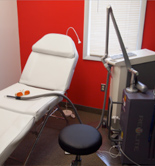 Tattoo removal treatment begins with the application of a topical anesthetic that is generally a cream applied to the skin. The laser treatment itself takes between 15 to 45 minutes depending on the size of the tattoo. During treatment, patients will hear a snapping sound and feel a dull sensation of an elastic band hitting their skin. Because the skin has been numbed by the topical anesthetic, they are only feeling the pressure to the treated area. Modern machines cause considerably less discomfort than the older machines.
Tattoo removal treatment begins with the application of a topical anesthetic that is generally a cream applied to the skin. The laser treatment itself takes between 15 to 45 minutes depending on the size of the tattoo. During treatment, patients will hear a snapping sound and feel a dull sensation of an elastic band hitting their skin. Because the skin has been numbed by the topical anesthetic, they are only feeling the pressure to the treated area. Modern machines cause considerably less discomfort than the older machines.
Skin care after tattoo removal treatment is pretty much the same as caregiving to skin just after getting a tattoo. Gentle cleaning and application of antibiotic cream will help hasten the healing process. The tattoo may feel warm like a sunburn and could be red and swollen for the rest of the day. Patients should expect the area to remain reddened for two to four weeks. Often, a scab in the color or the tattoo pigment will form and peal off after about a week. This is due to the body’s normal immune response to remove the dyes. Some patients will experience darkening or lightening of the treated skin for the next few months. Treatment is continued every 8 to 12 weeks, allowing the immune system to recover from the treatment.
Unlike Botox or soft tissue filler, which reveal instant results, tattoo removal is a more gradual process. Patients can expect 30% improvement after the first three treatments and after that 5-8% improvement after each treatment. Patients need to be committed with realistic expectations. However, complete removal of many tattoos is possible, albeit time consuming. The goal of effective treatment is to remove the tattoo pigment while leaving the skin’s own natural pigment intact. Patients do not want their tattoo replaced by ghosted white spots or scarring. Often the black and green pigments are gone first while treatment will continue on the yellows, blues and then lastly the light oranges.
